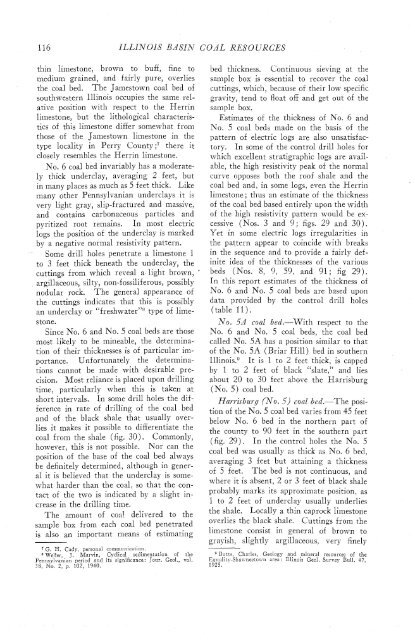subsurface geology and coal resources of the pennsylvanian system ...
subsurface geology and coal resources of the pennsylvanian system ...
subsurface geology and coal resources of the pennsylvanian system ...
You also want an ePaper? Increase the reach of your titles
YUMPU automatically turns print PDFs into web optimized ePapers that Google loves.
1 16 ILLINOIS BASIN COAL RESOURCES<br />
thin limestone, brown to buff, fine to<br />
medium grained, <strong>and</strong> fairly pure, overlies<br />
<strong>the</strong> <strong>coal</strong> bed. The Jamestown <strong>coal</strong> bed <strong>of</strong><br />
southwestern Illinois occupies <strong>the</strong> same relative<br />
position with respect to <strong>the</strong> Herrin<br />
limestone, but <strong>the</strong> lithological characteristics<br />
<strong>of</strong> this limestone differ somewhat from<br />
those <strong>of</strong> <strong>the</strong> Jamestown limestone in <strong>the</strong><br />
type locality in Perry C~unty;~ <strong>the</strong>re it<br />
closely resembles <strong>the</strong> Herrin limestone.<br />
No. 6 <strong>coal</strong> bed invariably has a moderately<br />
thick underclay, averaging 2 feet, but<br />
in many places as much as 5 feet thick. Like<br />
many o<strong>the</strong>r Pennsylvanian underclays it is<br />
very light gray, slip-fractured <strong>and</strong> massive,<br />
<strong>and</strong> contains carbonaceous particles <strong>and</strong><br />
pyritized root remains. In most electric<br />
logs <strong>the</strong> position <strong>of</strong> <strong>the</strong> underclay is marked<br />
by a negative normal resistivity pattern.<br />
Some drill holes penetrate a limestone 1<br />
to 3 feet thick beneath <strong>the</strong> underclay, <strong>the</strong><br />
cuttings from which reveal a. light brown,<br />
argillaceous, silty, non-fossiliferous, possibly<br />
nodular rock. The general appearance <strong>of</strong><br />
<strong>the</strong> cuttings indicates that this is possibly<br />
an underclay or "freshwater"Vype <strong>of</strong> limestone.<br />
Since No. 6 <strong>and</strong> No. 5 <strong>coal</strong> beds are those<br />
most likely to be mineable, <strong>the</strong> determination<br />
<strong>of</strong> <strong>the</strong>ir thicknesses is <strong>of</strong> particular importance.<br />
Unfortunately <strong>the</strong> determinations<br />
cannot be made with desirable precision.<br />
Most reliance is placed upon drilling<br />
time, particularly when this is taken at<br />
short intervals. In some drill holes <strong>the</strong> difference<br />
in rate <strong>of</strong> drilling <strong>of</strong> <strong>the</strong> <strong>coal</strong> bed<br />
<strong>and</strong> <strong>of</strong> <strong>the</strong> black shale that usually overlies<br />
it makes it possible to differentiate <strong>the</strong><br />
<strong>coal</strong> from <strong>the</strong> shale (fig. 30). Commonly,<br />
however, this is not possible. Nor can <strong>the</strong><br />
position <strong>of</strong> <strong>the</strong> base <strong>of</strong> <strong>the</strong> <strong>coal</strong> bed always<br />
be definitely determined, although in general<br />
it is believed that <strong>the</strong> underclay is somewhat<br />
harder than <strong>the</strong> <strong>coal</strong>, so that <strong>the</strong> contact<br />
<strong>of</strong> <strong>the</strong> two is indicated by a slight increase<br />
in <strong>the</strong> drilling time.<br />
The amount <strong>of</strong> <strong>coal</strong> delivered to <strong>the</strong><br />
sample box from each <strong>coal</strong> bed penetrated<br />
is also an important means <strong>of</strong> estimating<br />
'1 G. 13. Zady, personal communication.<br />
J. Marvin, Cyclical sedimentation <strong>of</strong> <strong>the</strong><br />
~enns~~vahian period <strong>and</strong> its significance: Jour. Geol., vol.<br />
38, No. 2, p. 102, 1940.<br />
bed thickness. Continuous sieving at <strong>the</strong><br />
sample box is essential to recover <strong>the</strong> <strong>coal</strong><br />
cuttings, which, because <strong>of</strong> <strong>the</strong>ir low specific<br />
gravity, tend to float <strong>of</strong>f <strong>and</strong> get out <strong>of</strong> <strong>the</strong><br />
sample box.<br />
Estimates <strong>of</strong> <strong>the</strong> thickness <strong>of</strong> No. 6 <strong>and</strong><br />
No. 5 <strong>coal</strong> beds made on <strong>the</strong> basis <strong>of</strong> <strong>the</strong><br />
pattern <strong>of</strong> electric logs are also unsatisfactory.<br />
In some <strong>of</strong> <strong>the</strong> control drill holes for<br />
which excellent stratigraphic logs are available,<br />
<strong>the</strong> high resistivity peak <strong>of</strong> <strong>the</strong> normal<br />
curve opposes both <strong>the</strong> ro<strong>of</strong> shale <strong>and</strong> <strong>the</strong><br />
<strong>coal</strong> bed <strong>and</strong>, in some logs, even <strong>the</strong> Herrin<br />
limestone; thus an estimate <strong>of</strong> <strong>the</strong> thickness<br />
<strong>of</strong> <strong>the</strong> <strong>coal</strong> bed based entirely upon <strong>the</strong> width<br />
<strong>of</strong> <strong>the</strong> high resistivity pattern would be excessive<br />
(Nos. 3 <strong>and</strong> 9; figs. 29 <strong>and</strong> 30).<br />
Yet in some electric logs irregularities in<br />
<strong>the</strong> pattern appear to coincide with breaks<br />
in <strong>the</strong> sequence <strong>and</strong> to provide a fairly definite<br />
idea <strong>of</strong> <strong>the</strong> thicknesses <strong>of</strong> <strong>the</strong> various<br />
beds (Nos. 8, 9, 59, <strong>and</strong> 91 ; fig 29).<br />
In this report estimates <strong>of</strong> <strong>the</strong> thickness <strong>of</strong><br />
No. 6 <strong>and</strong> No. 5 <strong>coal</strong> beds are based upm<br />
data provided by <strong>the</strong> control drill holes<br />
(table 11).<br />
No. 5A <strong>coal</strong> bed.-With respect to <strong>the</strong><br />
No. 6 <strong>and</strong> No. 5 <strong>coal</strong> beds, <strong>the</strong> <strong>coal</strong> bed<br />
called No. 5A has a position similar to that<br />
<strong>of</strong> <strong>the</strong> No. 5A (Briar Mill) bed in sou<strong>the</strong>rn<br />
Illin~is.~ It is 1 to 2 feet thick, is capped<br />
by I to 2 feet <strong>of</strong> black "slate," <strong>and</strong> lies<br />
about 20 to 30 feet above <strong>the</strong> Harrisburg<br />
(No. 5) <strong>coal</strong> bed.<br />
Harrisburg (No. 5) <strong>coal</strong> bed.-The position<br />
<strong>of</strong> <strong>the</strong> No. 5 <strong>coal</strong> bed varies from 45 feet<br />
below No. 6 bed in <strong>the</strong> nor<strong>the</strong>rn part <strong>of</strong><br />
<strong>the</strong> county to 90 feet in <strong>the</strong> sou<strong>the</strong>rn part<br />
(fig. 29). In <strong>the</strong> control holes <strong>the</strong> No. 5<br />
<strong>coal</strong> bed was usually as thick as No, 6 bed,<br />
averaging 3 feet but attaining a thickness<br />
<strong>of</strong> 5 feet. The bed is not continuous, <strong>and</strong><br />
where it is absent, 2 or 3 feet o,f black shale<br />
probably marks its approximate position, as<br />
1 to 2 feet <strong>of</strong> underclay usually underlies<br />
<strong>the</strong> shale. Locally a thin capmck limestone<br />
overlies <strong>the</strong> black shale. Cuttings from <strong>the</strong><br />
limestone consist in general o,f brown to<br />
grayish, slightly argillaceous, very finely<br />
"~~tts, Charles, Geology <strong>and</strong> mineral <strong>resources</strong> <strong>of</strong> <strong>the</strong><br />
Eqr~ali~~-Slia\vneetc~~ area: Illinois Geol. Survey Bull. 47,<br />
1925.
















